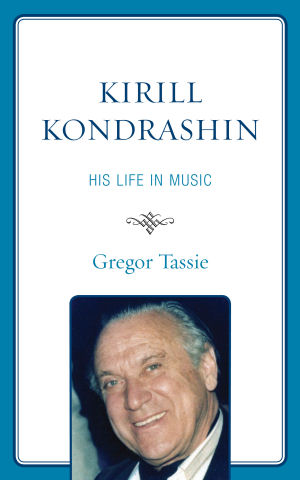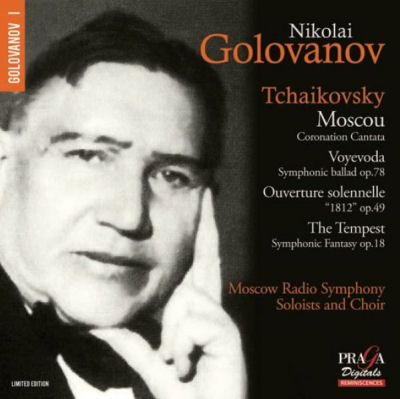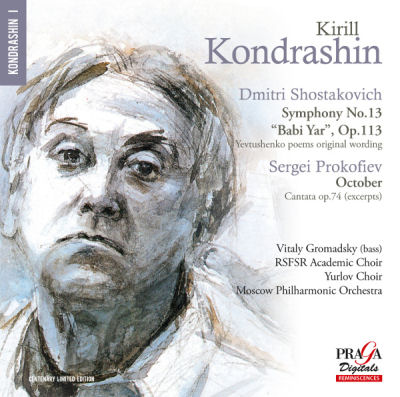Kirill Kondrashin – A life in music

This book was published in 2010. It is a very interesting survey on the musical life in USSR before Kondrashin’s [1914-1981] departure for the West in 1978. The author is a little hagiographic about this conductor, to the detriment of Svetlanov.
His parents were violinists and since his youth he only wanted to become a conductor. A pupil of Boris Khaikin, he will be the chief conductor of the Maly Theater (1936-1943), before being at the head of the Moscow Philharmonic (1960-1966). In 1938, the Committee of Arts set the first all Unions conducting competition in Moscow (2 weeks long). Is was won by Mravinsky, followed by Karl Eliasberg, Kondrashin and Zhukov. His debut concert with the Moscow Philharmonic will occur the same year with David Oistrakh. Appointed as a staff cinductor at the Bolshoi Theater in 1949, he will receive the Stalin price in 1958 and conducts at the piano Tachaikosky competition, thus touring with van Cliburn in the USA. He will give premieres of Shostakovich’s 4th & 13th, Wainberg’s 4th, Khachaturian’s Concerto-rhapsody for violin, Schedrin’s Naughty Lemerics and the suite No love alone, Levitin’s Cello concerto, Sviridov’s Kurks songs and Prokofiev’s Cantata, Scriabin’s Prefatory Act Universe (1973) and Boris Tchaikovsky’s Theme and variations in 1974. After applying for asylum in the Netherlands, he will be permanent conductor with the Concertgebouw orchestra. In 1980 he will be appointed to be the chief conductor of the Bavarian Radio symphony orchestra for 1982 to succeed Kubelík; his death will keep Kubelík as principal conductor until 1985.
His dicography isn’t very extensive (some Russian tapes had been destroyed after his dismiss). Most popular are his Shostakovich complete symphonies, concertos (he was considered as the best accompanist) and gave many concerts and great recordings with Oistrakh, Kogan, Richter, Gilels or with Westerners van Cliburn, Byron Janis or Martha Argerich.
Though I don’t consider his Scheherazade as the best recording ever, as many critics do, he made for me one the greatest recordings ever: Rachmaninov’s Symphonic danses in Moscow (there is also a great concert of this piece later with the Concertgebouw).
Excerpts
(too bad its index is both wrong and incomplete)
1812
One of the two concerts at the Royal Albert Hall drew many thousands, for three of the greatest violinists were on stage – the two Oistrakhs, David and Igor, and Yehudi Menuhin. « The ensemble was also unshakeable thanks to Mr. Kondrashin’s highly charged rhythmic vitality, here the perfect match for Vivaldi’s own. » On another evening, more orchestral fireworks were on show. The more popular Russian pieces were given; Tchaikovsky was represented by the Piano Concerto No. 1 in B-flat Minor, in which Fliyer was soloist, and the redoubtable 1812 Overture, in which the Moscow Philharmonic was joined by the band of the Coldstream Guards. There were no cannon or rifle-shots but a grand blaze of tone when the Russian Orthodox chant is triumphant. The concert was notable also in that Kondrashin gave the London public the Soviet version whereby Bozhe khrani is replaced by the Soviet national anthem. The Times writer commented: « Poor Tchaikovsky never thought of, though no doubt it sounds well enough to those who have not heard the old tune thunder out in the bars. Would it still corrupt good Russians, or even Westerners, to hear what the composer wrote? » Kondrashin took the occasion to unleash another modern Soviet work to his audience. « The last of the Soviet novelties, Shchedrin’s Limerick, turned out to be much the more enjoyable . . . bright-spirited, extremely amusing music and that it pays homage to the spirit of the nonsense poems which we associate with Edward Lear. » The piece is a sort of perpetuum mobile, involving a number of brilliant and original orchestral effects, some jazzy tunes and off-beat rhythmic patterns, and a curious, perhaps unwitting, kinship with Malcolm Arnold at his most uproarious and reckless. The Times, nevertheless, went on to praise this « as deft and original as this is most welcome, more so than”.
See:

Klemperer
Klemperer was so tall that he didn’t require a conventional podium, and wearing large black horn-rimmed glasses, the impression created was that he soared over the musicians, hypnotizing them with both his eyes and body movements. Klemperer, however, had a short fuse and often lost his temper. « When the first flute made an error, Klemperer caustically observed, seems as though you’ve never played in Beethoven’s Seventh Symphony.’ The flautist gravely nodded assent, whereupon Klemperer yelled, `You should be in a waxworks, not an orchestra.’ The flautist quietly replied, `Ask the maestro if he knows Glinka’s A Life for the Tsar.’ Klemperer: ‘What’s that?’ Flautist: `Tell the maestro that there is a spare place beside me in the waxworks. »
Critics
« There is little lyrical refinement about their playing . . . Dispensing with a baton, he gives the impression of being forced to exaggerate the rhythmic precision of his hand-movement, and the result at times has a touch of puppetry about it. His techniques and approach, especially in quick movements, all too often result in metronomic rigidity without a trace of the underlying rhythmic ground-swell that permits some conductors to use rubato without destroying the continuity of their argument. »
English humour
« Kondrashin’s reading of the Pathetic [sic] Symphony was so artificial and melodramatic that one began to feel a touch of national pride—for clearly Tchaikovsky is an English invention, misunderstood by these foreigners. »
Prokofiev
Away from the celebrity circuit, reviving music by his country’s composers continued to prove an integral part of Kondrashin’s work with the Philharmonic. In 1966, Moshei Grinberg suggested yet another neglected score to Kondrashin; this was the unperformed Cantata for the Twentieth Anniversary of the October Revolution written by Sergey Prokofiev in 1937. It was significant that Grinberg himself had a unique part in the work’s history:
Prokofiev’s cantata is for me a great novelty, a creative achievement inspired by his civil duty. The work is astonishing in its unusual freshness and the scale of its concept. One also feels some sort of naïveté mixed with poster art. But how sincerely the composer opens out the words of V. I. Lenin’s What is to be Done – « We pass in a closely knit group along a difficult path, holding our hands tightly. » Or take the other example [from] Philosophers where the voices slowly rire from whispers to freely sung works by Marx about philosophers which « in only diverse images explained the world during the time when the world needs to be remade. » I am the sole living witness to the audition of this cantata given in the summer of 1937 for P. M. Kerzhentsev (First Chair of the All-Union Committee for Arts). I remember how Platon Mikhailovich said « How can you Sergey Sergeyevich really take such texts which belong to the people and put them next to such forsaken music? » One has to add that Prokofiev vocalized very poorly although at the piano he played magnificently. Next to him were A. V. Gauk and B. E. Guzman. There were no copies of the music available. Therefore the criticism was fully accepted by the composer and as a result the work lay unperformed for 28 years! We performed the work several times in Moscow, toured it to Latvia and it was well received everywhere. I heard how the audience exchanged comments « I never thought Feuerbach’s Thesis could be sung and that it would prove to be so memorable.”
See:

Symphonic Danses
It is well known that Rachmaninov wanted to name the three movements Morning, Midday, and Evening. This cannot relate to a suite of dances and their development as an integral form, because they can be better titled as Night. This is the feelings of a disturbed man during a sleepless night. When he rests, ail the agonies of hypnosis are mercilessly evaluated . . . It is characteristic of all one’ s nostalgic compositions and the program of the Symphonic Dances compares in a way to Bartok’s Concerto for Orchestra. This is also a refrain from America, and the long lost motherland to the America of machines and automatons. Machine-like dryness is counter to Russian song, the span of the mother earth. The opening rises from a monotonous and repetitive grain: the birth of thought from a wide awake intellect. Fragments appear from intonations of the first theme. Then a contemplative tranquility is suddenly broken by sharp chords. It is as if one has switched on a saw, which with devilish power is striking at one’s head Sometimes there cry pitiful human voices on clarinet and oboe but are drowned out in an uninterrupted, hammering forte. Following a pause, there enters the middle section which brings us to Russia . . . It is as if memories do not corne at once, only gradually. And when everything leads to the appearance of the main theme on the saxophone—you are already in Russia. We hear Russian voices, akin to folk Tore, with the characteristic breath of Russian song. Perhaps no other composer, apart from Rachmaninov, can come close to this. Each performer brings his own to this by inconsistent tempi (it is impossible to play this uniformly), and by phrasing. This nostalgia is continuously scored by the composer, sometimes not, by,the fading out of the sound through prolonged notes archetypal for Russian folk song. The whole of the middle section contains one frame of mind. This is the theme of Russia, of Russian nature, of everything that surrounded Rachmaninov from childhood. Slowly the theme dies away. The three last bars are as if a fading poignant recollection.
After bar 17 there sounds a bass-clarinet which returns us to programmed subject matter. The clarinets singing repeats the voices of the first sharp chords, the low tuba with the double-bassoon plus timpani and cymbals are a sudden reawakening from the past. Hysteria a11 but reigns with the return of the celebratory perfunctory opening, after which there returns a Russian song-like theme. The musicologist Svetlana Vinogradova has said that this may be compared to
the psychological outline of the song « Farewell, my joy, my life » which was made famous by Shalyapin’ s recording. This is in my opinion spot on. This is really the main theme from the First Symphony by Rachmaninov, the most problematic performance for him, and the Jack of success of which led to a prolonged crisis. And far from roots, even the most painful past memories can ring out brightly as they are linked with lost youth and his maternai home. It is remarkable that Rachmaninov could not expect that this melody would becorne famous as his own signature tune. The score of the First Symphony was destroyed by him in 1895 and only two years after his death was restored from the preserved orchestral parts.
At bar 28 we return to the rhythmic essence. Many conductors using the previous meno mosso adopt the former tempo. I don’ t agree with this. Rachmaninov did not indicate a change in tempo, but naturally the appearance of this song-like theme calls for restraint, and at this measured Pace the movement must conclude because the return of the opening rhythm and intonation of the main theme do not bear an oppressive character. They are perhaps like the hurting to which man is accustomed. This is within, but always the mood is the same— »Farewell, joy, my life! »
The third movement is for me the most fascinating. I conduct some of the thematic material differently from that normally done. The essence being that the motif « Dies irae » is present in almost ail Rachmaninov’ s life and throughout almost ail his works. This theme always bears an evil, negative character with Rachmaninov as do other composers who utilise this idea. To understand my conception, it is essential to underline that this theme is used in several pieces written in Russia. For Rachmaninov it is associated with his earlier inspiration, but here is presented in two aspects—positive and negative. The opening is in a sharp chord and then a voice of frustration. One awakes in the morning and suddenly you remember something unpleasant. This is accompanied by shuddering. Another few seconds you corne to yourself and are fully in power of one’ s self. It is mocking, beating, convulsing: the venomous cheeping of bassoons, the short spasms of phrasing on the cellos, the outburst of the whole orchestra offer an echo, as if a funereal toll from afar. And there begins a carnival on an Bides of automatons—dancing, syncopating rhythms, unsightly changing ail the time in size. The voices of « Dies irae » are given in distorted form. Sometimes there appear horrifying intonations, before bar 61, on clarinets and bassoons. This represents some kind of attempt at confrontation. Yet everything is mercilessly suppressed. The new variation of the theme arrives on the flute and xylophone. Ail this reaches a culmination before bar 70, and it would appear that already no one can resist. But the noise abates. The glowering voices begin to enter the
central section, again built around the modified « Dies irae. » Here is where it seems to me that here « Dies irae » is no longer negative. Here it symbolises the
lost motherland. I underline that although Rachmaninov several times uses this
theme negatively, here it is « the spirit of motherland » recollecting a land far-off, yet his own . . . In two parts of the American edition there are the inscription
Alleluia (at measure 2 of 99 bar and measure 2 at 100 bar). I take this as lamentation for lost hope—interrupted by the triumphant voices of the orchestra . The last toll of the bell is so true; here man realises that he will be buried on foreign soil . . . Of course this is an integrated work. Everything here is in the confrontation with reality and to what has left him . . The Symphonic Dances were written not long before his death. After this he did not write anything else. All the American compositions by Rachmaninov are nostalgie: Three Russian Choruses, Rhapsody on a Theme of Paganini, the Third Symphony, however the Symphonic Dances are his farewell . . . How can one entitle this composition best? A symphony? No, it is far from that in form. Neither is it an orchestral suite because ail the movements occupy a similar mood. Perhaps one could inscribe on the score « Here you expect something, but get something quite different . . . » Something incongruous like: The Dances of Death.
